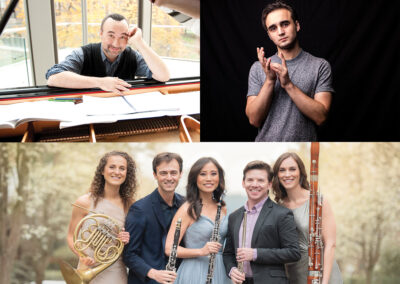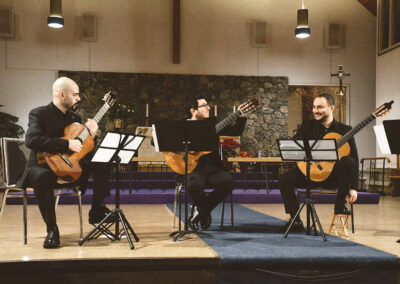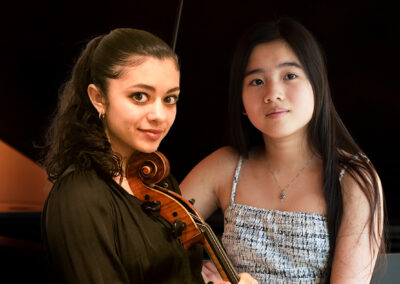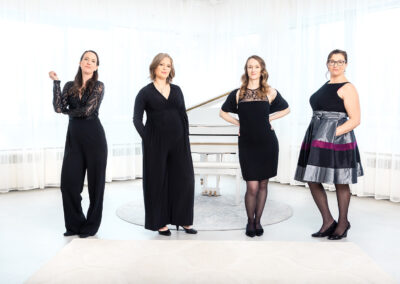Step back to a flamboyant moment in musical history with cellist Elinor Frey and Rosa Barocca under the direction of Claude Lapalme. Not only is Elinor Frey an accomplished and expressive musician, her expertise in the history of string instruments illuminates this performance. Together with Rosa Barocca, this concert program invites you to experience the radiance and dynamism of Baroque music in Italy – and to understand the evolution of the instruments themselves. With a program featuring material from their 2023 Juno award-winning album, the ensemble highlights the spectacular flair of early Italian cello concerts from the Baroque era.
Album review
“Along with Rosa Barocca’s committed and dynamic playing, Elinor Frey’s period sensitive and highly expressive interpretations teleport the spirit of a baroque ensemble (minus the powdered wigs of course)…”
– Classical Music Sentinel

photo | Elizabeth Delage
Elinor Frey
Elinor Frey is a leading Canadian-American cellist, gambist, and researcher. Many of her albums on the Belgian label Passacaille and Canadian label Analekta are world premiere recordings. They include Giuseppe Clemente Dall’Abaco Cello Sonatas (winner of a Diapason d’Or) and Early Italian Cello Concertos (winner of the 2023 JUNO Award for Classical Album of the Year – Small Ensemble). Elinor’s critical editions of Dall’Abaco’s cello music are published in collaboration with Walhall Editions.
Elinor is the artistic director of Accademia de’ Dissonanti, an organization for performance and research. She has appeared throughout the Americas and in Europe in recital and with numerous chamber ensembles and orchestras, including Rosa Barocca, Constantinople, Les idées heureuses, Il Gardellino, Tafelmusik, and the Pacific Baroque Orchestra.). In March 2023, Elinor performed Boccherini and Sammartini concertos with the Australian Brandenburg Orchestra.
Elinor holds degrees from McGill, Mannes, and Juilliard, and is the recipient of dozens of grants and prizes supporting performance and research, including the US-Italy Fulbright Fellowship studying with Paolo Beschi in Como, Italy, and a recent research residency at the Orpheus Institute in Ghent. She teaches Baroque cello and performance practice at McGill University and the Université de Montréal, and is a Visiting Fellow in Music (2020–2023) at Lady Margaret Hall, Oxford University. In 2021, Frey was awarded Québec’s Opus Prize for “Performer of the Year.”
Learn more
elinorfrey.com

Rosa Barocca
Rosa Barocca’s mission is to present Alberta audiences with historically-informed performances of Baroque music. They use period instruments to capture the spirit, stylistic approach and distinctive sound of that glorious musical era. Comprised of musicians from across Canada, the newly-minted ensemble debuted in November 2016 with two greatly acclaimed performances of Purcell’s “Hail! Bright Cecilia” in Calgary and Red Deer under their Artistic Director Claude Lapalme.
Rosa Barocca’s recent album, featuring internationally-acclaimed cellist Elinor Frey, was nominated for a Juno Award in the category of Best Classical Album of the Year – Small Ensemble.
Learn more
rosabarocca.ca
Program
.This program selection puts the range and dynamism of the Baroque period on full display.
Selections
George Frideric Handel: Concerto Grosso Op. 6 No. 2 in F Major, HWV 320
1. Andante Larghetto
2. Allegro
3. Largo
4. Allegro ma non troppo
Antonio Vivaldi: Cello Concerto in G major RV 414
Soloist: Elinor Frey, cello
1. Allegro molto
2. Largo
3. Allegro
Intermission
Carl Philipp Emanuel Bach: Concerto in A major, Wq. 172 (H.437-9)
Soloist: Elinor Frey, cello
1. Allegro
2. Largo con sordini, mesto
3. Allegro assai
Carl Philipp Emanuel Bach: Sinfonia in B minor, H.661 (Wq.182/5)
1. Allegro di molto
2. Poco Adagio
3. Presto
Program Notes
On the Handel Concert Grosso
The Concerto Grosso Op. 6 No. 2 in F Major is part of a collection of twelve concerti grossi, Op. 6, which Handel composed in 1739. This set is considered one of the finest examples of the concerto grosso form, a popular style during the Baroque period where music is contrasted between a small group of soloists (concertino) and the full orchestra (ripieno).
The Op. 6 No. 2 is structured differently from of Handel’s concerti grossi, featuring only four movements instead of the typical five or six.
- Andante Larghetto: The opening movement sets a stately and dignified tone, characterized by elegant melodic lines and a graceful interaction between the concertino and ripieno. The overall sweetness of the music owes a great debt to Arcangelo Corelli’s set of of 12 Concerti Grossi (also opus 6), which Handel took as a model for his own set.
- Allegro: This movement shifts to a more lively and energetic mood, with vigorous and rhythmic outbursts, displaying Handel’s skill in creating engaging and intricate contrapuntal textures. The interplay between the soloists and the orchestra most engaging and the virtuosity displayed by the two solo violinist is most entertaining.
- Largo: This third movement offers a contrasting serene and contemplative mood. It features a beautifully crafted melody that showcases Handel’s ability in a truly “cantabile”, or singing style.
- Allegro ma non troppo: The concerto concludes with a movement which, while brisk, maintains a level of restraint in tempo. It still displays great vitality and the dialogue between the concertino group and the full ensemble is most spirited, bringing the concerto to a joyful and satisfying conclusion.
On the Vivaldi Concerto
Vivaldi’s G major cello concerto exists in a version for flute, catalogued as RV 438. However, signs of revision typical of Vivaldi’s work process indicate that RV 414 is likely the first version. A rare Allegro molto marking in the first movement, indicating a brisk tempo, the soloist’s ascent to a high d’ in the third movement, and a variety of spirited passages that highlight the cello’s wide range and natural bravura all place the concerto in a virtuosic domain. Like so many of Vivaldi’s works, the concerto is dazzling, charming, sensuous, and ultimately beautiful; a jewel among Vivaldi’s many celebrated contributions to cello music.
On the works by Bach
Carl Philipp Emanuel Bach, a prominent figure in the musical transition between the Baroque and Classical eras, is often celebrated for his innovative and emotionally charged compositions. His work is characterized by its expressive depth, often venturing into bold harmonic territories and featuring unexpected twists in melody and rhythm. These qualities exemplify the Empfindsamer Stil, or “sensitive style”, which aimed to express genuine emotions and human experiences in music, in contrast to the more restrained German music of the high baroque.
These cello concertos are noteworthy for their innovation and expressive depth. Written during a period when the cello was gaining prominence as a solo instrument, these concertos showcase Bach’s forward-looking compositional style. They blend the intricate polyphony typical of the Baroque with the emerging Classical style’s clarity and balanced form. Tonight’s concerto exhibits Bach’s adventurous harmonic language. He frequently uses unexpected key changes and chromaticism to heighten the emotional intensity of the music especially in the second movement. The rhythmic energy of the concerto, typical of the composer’s style, is exemplified in the outer movements.
The Sinfonia in B minor, H.661 (Wq.182/5), is part of a set of six string symphonies (H.657-662, Wq.182) composed in 1773. These works were dedicated to Baron Gottfried van Swieten, an Austrian diplomat and a patron of the arts who was a significant figure in the musical lives of both C.P.E. Bach and later, Mozart and Beethoven.
True to the Sturm und Drang (‘Storm and Stress’) movement with its unmistakable impetuosity, this sinfonia is notable for its dramatic and intense emotional expression. It consists of three movements: Allegro di molto, Poco adagio, and Presto.
- First Movement (Allegro di molto): The opening movement is characterized by its driving energy and rhythmic force. The use of minor tonality adds to the dramatic and somewhat turbulent mood, showcasing Bach’s innovative approach to harmonic progression and thematic development.
- Second Movement (Poco adagio): In stark contrast to the first, this movement is more introspective and lyrical. The use of muted strings creates a subdued and intimate atmosphere. The expressive melodic lines are a testament to Bach’s ability to convey deep, yet subtle emotions, moving gracefully through various shades of sentiment.
- Third Movement (Presto): The finale is vigorous and lively, with a brisk tempo that brings back the drama of the first movement. The rapid string passages and energetic rhythms make this a fittingly vibrant conclusion to the sinfonia.







